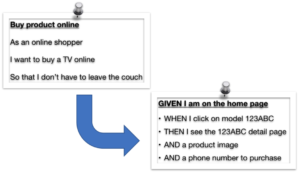Poor requirements don’t impede projects, missing requirements do.
Experience has taught us that one approach stands above all others when you want to scour for missing requirements—consider ‘dry runs’ by using various scenarios found in scenario planning. Strive to build a range of understanding from the sunny and optimistic “sunny skies” (best case—rare) through the calamitous “stormy skies” (worst case—rare). For robust analysis, include partly sunny and/or partly cloudy conditions (most likely or frequent cases).
For example, recently a vendor offered us a twenty percent discount for making a second purchase. However, without cookies and screen history, their site defaulted to their ‘new customer’ discount of ten percent. Thus, we were unable to use their ‘special offer.’ They had gathered the initial requirements properly (i.e., ten percent discount for new customers) but had not considered the occasional exception (special twenty percent discounts). Scenario planning built around functional requirements helps you anticipate and identify ‘exceptions’ while building more rigorous acceptance criteria.
User Story Procedure
A familiar format for compiling User Stories completes the following procedure but does not anticipate exceptions or conditions. For example, what alternative story develops when a customer’s electricity is interrupted? What might customers do differently if they suddenly realize a financial windfall such as a tax return? Standard approaches create a baseline but do not leverage structure to understand or extract requirements under ALL conditions.
As a _____________________ (persona)
I want ____________________ (functionality)
So that ___________________ (I get business value or benefit)
Gherkin Syntax
For others’ User Stories, some people prefer using the Gherkin Syntax. Complete the Gherkin Syntax from each persona’s perspective. However, it also lacks the rigor to explore or prompt for specific exceptions rather than baseline standards.
- GIVEN [and] <precondition>
- WHEN [and] <user action>
- THEN [and] <user action>
The INVEST Test
INVEST represents a mnemonic for testing the thoroughness of each User Story by discretely testing against each of its six components. While INVEST helps validate (or not) a User Story, it also fails to provide a clear and stimulating means to test for what may be missing.
- I = Independent (self-contained)
- N = Negotiable (not overly specific)
- V = Valuable (accompanied by acceptance criteria)
- E = Estimable (relative sizing)
- S = Small (optimally completed within two days, maximum)
- T = Testable (from a user perspective)
The Epic Exception
Commonly you will see flows from a product development perspective that look something like this (except for the red line). While this displays a myopic, developers’ point of view, the customers’ perspective also includes special activities at various times during the year, such as the requirements of creating a budget versus requirements when reviewing or modifying a budget:
While the baseline flows above mostly capture the developer’s perspective, the customer also has acceptance criteria (associated with tasks) that occur irregularly, illustrated above as something that may occur every month or so.
Continue to establish your baseline, as you would today, but take it a step further. To avoid missing occasional features/stories/tasks, test your baseline using the principles of scenario planning. Whether you use structured and sequenced interviewing or build collective understanding through facilitated meetings and workshops, applying the logic and questions appropriate to scenarios improves the likelihood that you won’t miss substantive or critical requirements that rarely occur.
What is Scenario Planning?
Forward-looking deliverables such as five-year plans and shaping curves rely exclusively on the concept of probabilities since no future state is certain. Probabilities consist of shared assumptions, beliefs, and outlooks about some future state or condition.
You help isolate potentially missing requirements by exploring probabilities, particularly when evidence supports multiple outcomes. Scenario planning implies creating ranges and not relying on fixed numbers.
Use Scenario Planning to Create Ranges
Probabilities consist of commonly held assumptions, beliefs, and outlooks about some future state or condition. Forward-looking deliverables such as five-year plans and shaping curves rely exclusively on the concept of probabilities since no future state is certain. How can a facilitator help resolve arguments around conflicting probabilities, particularly when evidence supports multiple outcomes? Create ranges and not fixed numbers.
Strive to avoid building one set of ‘answers.’ Rather, build multiple answers—such as five answers based on perspectives suggested below. Facilitate mutual understanding around potentially different requirements that support five discrete scenario types.
Sunny Skies:
Dare your participants to think positively. Ask them to relieve themselves from concerns about risks and other exogenous factors. Strive to build and agree on a ‘best likely’ scenario, akin to Sunny Skies and Clear Sailing. Don’t allow impediments or other negative throttles. While probabilistically unlikely, the Sunny Skies scenario provides a bookend, number, or set of numbers that would unlikely ever be exceeded.
Stormy Skies:
Take your participants in the opposite direction. Allow for every conceivable catastrophe or injurious situation. Try to fall short of ‘bankruptcy’ or ‘going out of business’ (but relent if your participants make an urgent claim that complete “death” is one potential outcome).
Partly Sunny Skies:
Having built the two prior scenarios, take a closer look at the Sunny Skies scenario and toggle some of the less likely occurrences. Strive to make this view and set of numbers positive, but not extreme. If necessary, use the PowerBall tool to rank the importance of assumptions and only toggle the most important assumptions, leaving others untouched.
Partly Cloudy Skies:
With our Bookend rhetoric, move again in the opposite direction by taking a closer look at the Stormy Skies scenario and toggle some of its less likely occurrences. Here you want to lead to a set of negative numbers, but not in the extreme. Have them study past performance and downturns for reliable percentages. Again, if necessary, use the PowerBall tool to rank the impact of assumptions and only toggle the most impactful, leaving the others untouched.
Probable Skies:
Take the four scenarios and potential sets of numbers to derive discussion and consensus around the most likely. Force participants to defend their arguments with an appeal to the prioritized lists of assumptions and revisit the prioritization if necessary. Along the way, Scenario Planninglisten and note the most extreme numbers being suggested as ‘most likely’ because they can help establish the final range.
Further analysis can take the final range and establish targets and thresholds for on target performance (e.g., green lights), cautionary performance (eg, yellow lights), and intervention performance (e.g., red lights). The value of a facilitator is rarely greater than when serving as a referee for future conditions.
Most critically to your success, avoid unstructured discussions. Carefully and extensively document and define all assumptions. Remember to use your Definition tool, since frequently you will discover participants in violent agreement with each other!
NOTE: The value of a meeting facilitator is rarely greater than when serving as a referee for future conditions that cannot be proven, even when using evidence-based support.
Scenario planning approaches and questions unveil missed requirements and help provide more detail around user acceptance criteria. The approaches also provide value in general business situations, such as establishing thresholds for scorecard inputs and dashboards. Perhaps most importantly, as a facilitator, you will find they are fun and engaging. Arguing about prior performance can get heated. Arguing about potential futures keeps your situation much more lighthearted.
National Intelligence Council Support for Facilitating Scenario Planning
The MGRUSH Professional Facilitative Leadership training explains the importance of meeting design and facilitating scenario planning. Therefore, if you find yourself in that role, consider purchasing the USD$2 Kindle version of “Global Trends 2030: Alternative Worlds” to support your meeting design and preparation.
Future Scenarios
For instance, Robert Moran’s excellent summary can be found in “The Futurist” March-April 2013 issue, sponsored by the World Future Society.
- Fusion: an interconnected East and West collaborate to address global challenges and innovation blossoms as nearly everyone prospers.
- Genie out of the Bottle: gaping extremes describe the global environment and within countries and communities as the best positioned to reap most of the benefits of the new world order.
- Non-State: cities, NGOs (ie, non-governmental organizations), global elites, terror groups, and multinationals derive global change and chaos.
- Stalled Engines: the Pacific Rim engages in nationalistic brinkmanship and amplified conflict ensues. Global growth slows and the United States turns inward as globalization unravels.
Additionally, the report covers a forward view towards individual empowerment, diffusion of power, aging populations, mass urbanization, and accelerating change such as:
- 3-D printing and robotics revolutionize manufacturing
- America’s domination begins waning
- Economic power shifting East and South from the West and the North
- The global middle class continues to expand
- Hydraulic fracturing could make the USA energy-independent
- The threat of a pandemic looms
In other words, the scenarios provide your planning session and decision-makers with valid considerations. Therefore, to borrow directly from Mr Moran:
“With technology empowering the individual, the battle for the twenty-first century could be the battle of the self-organizing swarm against the command and control pyramid.”
In conclusion, let us know how your session turns out.
______
Don’t ruin your career by hosting bad meetings. Sign up for a workshop or send this to someone who should. MGRUSH workshops focus on meeting design and practice. Each person practices tools, methods, and activities daily during the week. Therefore, while some call this immersion, we call it the road to building high-value facilitation skills.
Our workshops also provide a superb way to earn up to 40 SEUs from the Scrum Alliance, 40 CDUs from IIBA, 40 Continuous Learning Points (CLPs) based on Federal Acquisition Certification Continuous Professional Learning Requirements using Training and Education activities, 40 Professional Development Units (PDUs) from SAVE International, as well as 4.0 CEUs for other professions. (See workshop and Reference Manual descriptions for details.)
Want a free 10-minute break timer? Sign up for our once-monthly newsletter HERE and receive a free timer along with four other of our favorite facilitation tools.
Go to the Facilitation Training Store to access proven, in-house resources, including fully annotated agendas, break timers, and templates. Finally, take a few seconds to buy us a cup of coffee and please SHARE with others.
In conclusion, we dare you to embrace the will, wisdom, and activities that amplify a facilitative leader. #facilitationtraining #MEETING DESIGN
______
With Bookmarks no longer a feature in WordPress, we need to append the following for your benefit and reference
- 20 Prioritization Techniques = https://foldingburritos.com/product-prioritization-techniques/
- Creativity Techniques = https://www.mycoted.com/Category:Creativity_Techniques
- Facilitation Training Calendar = https://mgrush.com/public-facilitation-training-calendar/
- Liberating Structures = http://www.liberatingstructures.com/ls-menu
- Management Methods = https://www.valuebasedmanagement.net
- Newseum = https://www.freedomforum.org/todaysfrontpages/
- People Search = https://pudding.cool/2019/05/people-map/
- Project Gutenberg = http://www.gutenberg.org/wiki/Main_Page
- Scrum Events Agendas = https://mgrush.com/blog/scrum-facilitation/
- Speed test = https://www.speedtest.net/result/8715401342
- Teleconference call = https://youtu.be/DYu_bGbZiiQ
- The Size of Space = https://neal.fun/size-of-space/
- Thiagi/ 400 ready-to-use training games = http://thiagi.net/archive/www/games.html
- Visualization methods = http://www.visual-literacy.org/periodic_table/periodic_table.html#
- Walking Gorilla = https://youtu.be/vJG698U2Mvo

Terrence Metz, president of MG RUSH Facilitation Training, was just 22-years-old and working as a Sales Engineer at Honeywell when he recognized a widespread problem—most meetings were ineffective and poorly led, wasting both time and company resources. However, he also observed meetings that worked. What set them apart? A well-prepared leader who structured the session to ensure participants contributed meaningfully and achieved clear outcomes.
Throughout his career, Metz, who earned an MBA from Kellogg (Northwestern University) experienced and also trained in various facilitation techniques. In 2004, he purchased MG RUSH where he shifted his focus toward improving established meeting designs and building a curriculum that would teach others how to lead, facilitate, and structure meetings that drive results. His expertise in training world-class facilitators led to the 2020 publication of Meetings That Get Results: A Guide to Building Better Meetings, a comprehensive resource on effectively building consensus.
Grounded in the principle that “nobody is smarter than everybody,” the book details the why, what, and how of building consensus when making decisions, planning, and solving problems. Along with a Participant’s Guide and supplemental workshops, it supports learning from foundational awareness to professional certification.
Metz’s first book, Change or Die: A Business Process Improvement Manual, tackled the challenges of process optimization. His upcoming book, Catalyst: Facilitating Innovation, focuses on meetings and workshops that don’t simply end when time runs out but conclude with actionable next steps and clear assignments—ensuring progress beyond discussions and ideas.





